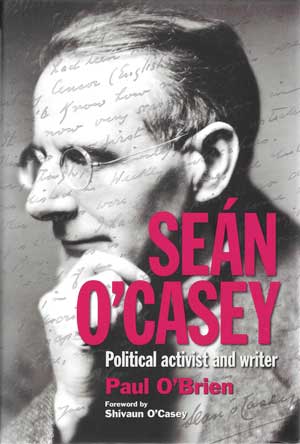PAUL O’BRIEN
Cork University Press
€49
ISBN 9781782053415
Reviewed by Nelson O’Ceallaigh Ritschel
Nelson O’Ceallaigh Ritschel is the author of Bernard Shaw, Seán O’Casey, and the dead James Connolly (Palgrave, 2021).

As the centennial years of Seán O’Casey’s Dublin trilogy plays, The Shadow of the Gunman (1923), Juno and the Paycock (1924) and The Plough and the Stars (1926), are upon us, we will encounter renewed interest in O’Casey and his plays. If Paul O’Brien’s Seán O’Casey: political activist and writer is any indication, it will be a welcomed revisitation of one of Ireland’s premier historical dramatists.
O’Brien sets his focus on ‘the social and political geography of O’Casey’s drama’. Since history, namely politics, is entwined in O’Casey’s plays, O’Brien wisely addresses how O’Casey presented his political ideologies. For example, in the iconic play on 1916, The Plough and the Stars, premiered at the Abbey Theatre in 1926, O’Casey set Act II in a public house in November 1915. A platform is visible through the pub’s large window where a man’s legs periodically come into view as he delivers excerpts from three Patrick Pearse speeches, including the closing words from the August 1915 O’Donovan Rossa eulogy delivered in Glasnevin Cemetery. Given Pearse’s unswerving temperance stance, placing him on a speakers’ platform outside a pub seems a blatant historical liberty, but O’Casey zeroes in on three characters as the act nears its end: Jack Clitheroe and Captain Brennan in their Irish Citizen Army (ICA) uniforms, with the latter carrying the ICA’s Plough and Stars, and Lieutenant Langon in his Irish Volunteers uniform carrying the tricolour. Entering the pub, inspired by Pearse’s words on blood sacrifice, they strengthen their resolve with alcohol. This connects to Act I, when Clitheroe is portrayed as vainly committing only for an officer’s rank—an impoverished worker from Dublin’s tenements seeking relevancy. So, while the historical record may not be strictly accurate, a historical truth is arguably reached. As O’Brien notes, ‘We have to read these [portrayed] incidents in the way O’Casey intended, as metaphors or symbolic ways of explaining the different ideas and political currents he encountered and tried to come to terms with’.
While O’Brien admirably builds on previous stellar works on O’Casey—The letters of Seán O’Casey (four volumes) edited by David Krause (1975–1992), Christopher Murray’s Seán O’Casey: writer at work (2004) and James Moran’s The theatre of Seán O’Casey (2013)—he moves carefully through O’Casey’s life with his constant development as a dramatist who also penned six autobiographical books (1939–54). He reveals how O’Casey’s political ideologies were shaped by the forces and individuals he encountered during his life (1880–1964). The Dublin poverty that O’Casey knew so well receives significant attention, especially the 1913 Lockout, from O’Casey’s efforts for the Women and Children’s Relief Fund to feed locked-out families through to the Lockout’s persistent threads that fed much of O’Casey’s literary work. Such threads included reactions to the machinations of some in the Irish Transport and General Workers’ Union and the Irish Labour Party, namely William O’Brien and Tom Foran, who divided the union and party into two camps after Connolly’s execution: one remaining faithful to James Larkin (imprisoned in the United States), and one claiming adherence to Connolly’s labour ideology in its effort to distance Larkin from leadership. Such divisions prompted O’Casey’s decades-long refutation of Connolly for involving the ICA in 1916. In this O’Brien sees a lost opportunity: ‘O’Casey could have stood by Connolly, linking his name with that of Larkin in the fight against capitalist exploitation and exposing the sham politics of William O’Brien and his friends in the Labour Party who claimed to speak in Connolly’s name’.
Along the way, O’Brien recognises Bernard Shaw’s importance to O’Casey, professionally and personally, acknowledging Shaw’s role in the formation of what became the ICA. This includes Shaw’s speech at a London rally on 1 November 1913 in support of locked-out workers, where he called for the arming of workers to defend themselves against the Dublin Metropolitan Police. Two weeks later, Connolly announced the formation of a citizen army. O’Brien, however, does not consider why O’Casey never referred to Shaw’s speech, not in The story of the Irish Citizen Army (1919) nor anywhere else.
There are a few oddities, such as the argument that O’Casey’s Great War play The Silver Tassie (1928) ‘is not an Irish play’, the reasoning being that ‘there are no references to the politics of the time or characters that represent political aspirations’. Yet there are echoes. Harry Heegan’s football club, Avondale, takes its name from Parnell’s Wicklow home, and the play is set in the Protestant working-class area of the East Wall. One might suggest that since many more Irish participated in the Great War than fought in 1916, 1919–21 or 1922–3 it is very much an Irish play. Moreover, O’Brien makes no mention of Shaw’s Great War play O’Flaherty V.C. (1915), despite Harry Heegan’s mother in The Silver Tassie expressing much the same concern over the British war separation allowance as Denis O’Flaherty’s mother in Shaw’s play. These, however, are mere quibbles.
O’Brien appropriately explores O’Casey’s post-1920s plays, such as Within the Gates (1933) and The Star Turns Red (1940), along with his friendships with American dramatist Eugene O’Neill and American critics George Jean Nathan and Brooks Atkinson. O’Brien also explores O’Casey’s 1950s response to the plays of Samuel Beckett and John Osborne, which ‘shows how out of touch he was with developments in modern theatre in the last decades of his life’.
Paul O’Brien has produced a valuable study of Seán O’Casey, who can never be denied his place among Ireland’s great dramatists.
